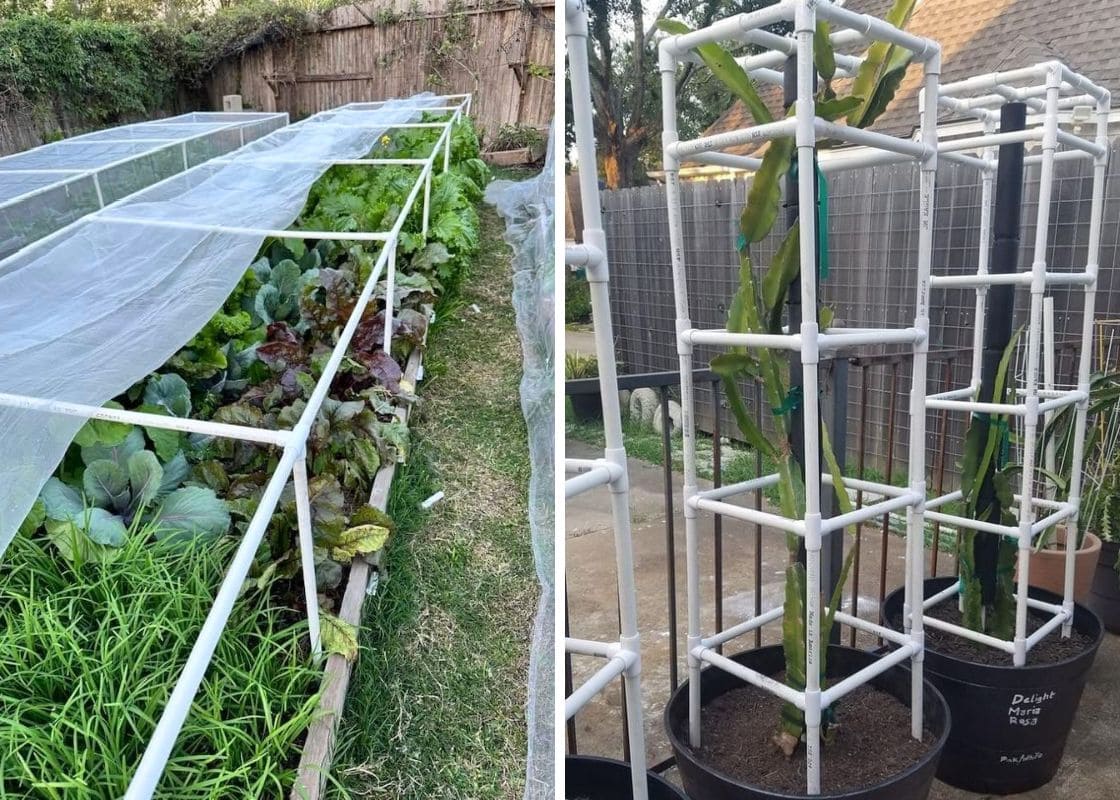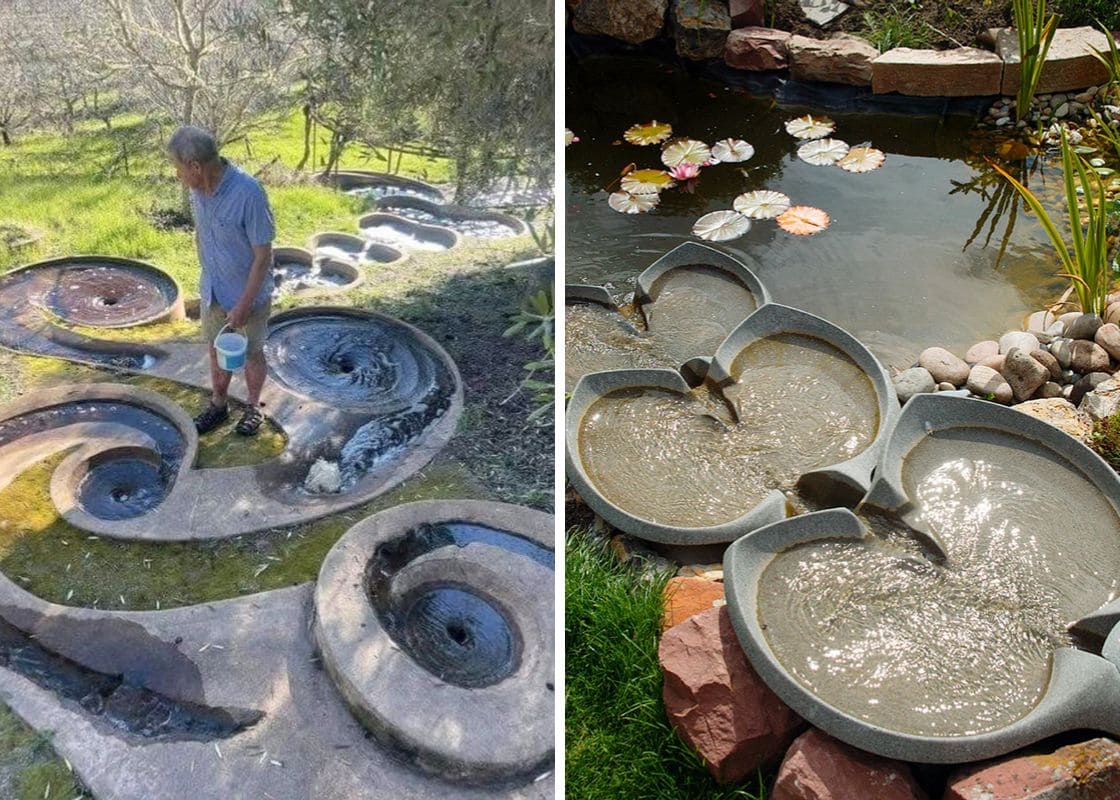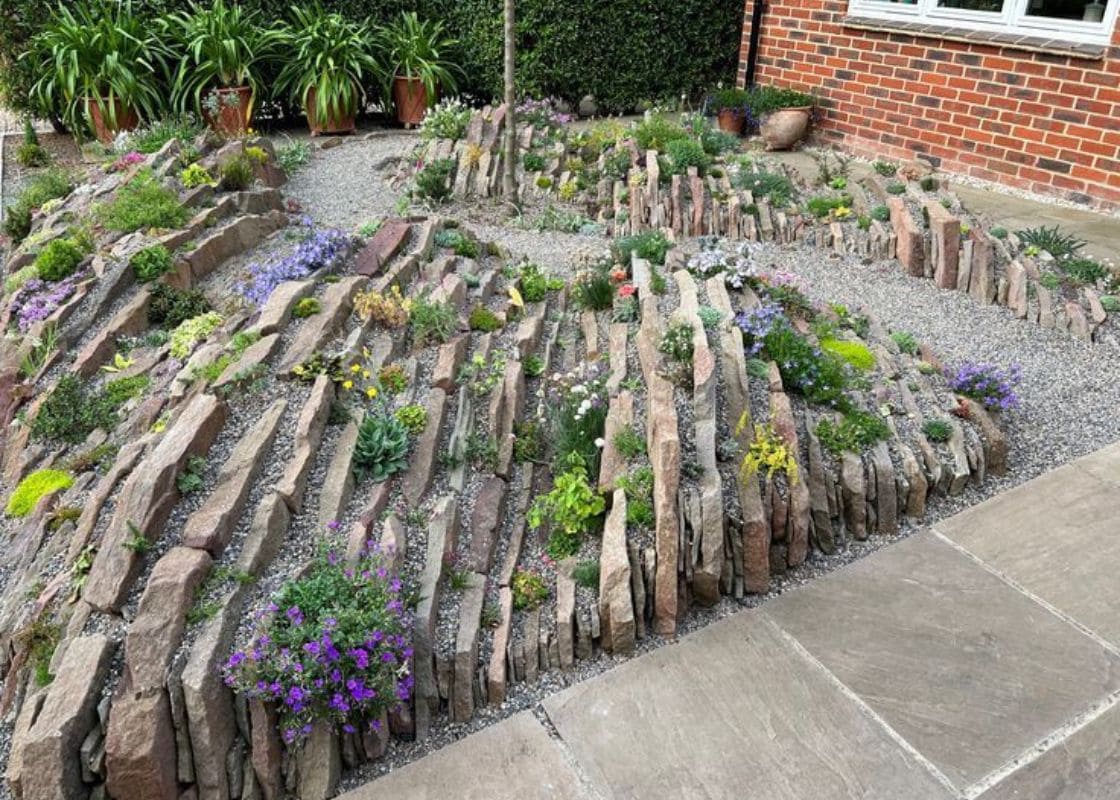Yellow is a color that exudes happiness, warmth, and positivity brightening up any space. It’s no better than seeing this color surrounding our house and garden.
One of the best ways to infuse your outdoor space with yellow is by planting yellow flowering bushes.
These shrubs not only add color but also offer numerous benefits such as attracting pollinators and enhancing garden health.
Weeping Forsythia (Forsythia Suspensa)
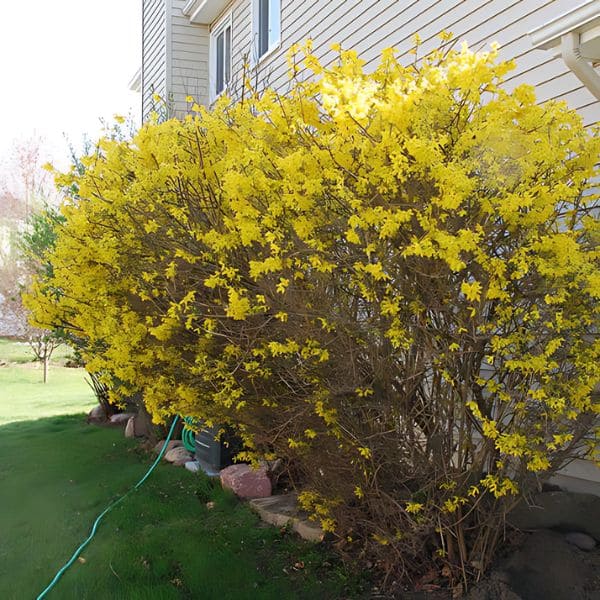
- Plant Size: 2-3 meters in height
- Bloom Time: Early spring
- Sun Exposure: Full sun to partial shade
- Soil Requirement: Well-drained soil
- Hardiness Zones: 5-8
Weeping forsythia is a deciduous shrub, known for its graceful, arching branches and vibrant yellow flowers, and can grow up to 2-3 meters tall.
This plant is renowned for its cascading branches covered in brilliant yellow flowers that bloom profusely in early spring.
It features lance-shaped green leaves that turn yellow or purplish in the fall. It also grows at a fast rate, thriving best in full sun to partial shade.
The flowers of the weeping forsythia are not only beautiful but also serve as an early nectar source for bees and butterflies.
In traditional Chinese medicine, its fruit has been used for centuries for its believed health benefits.
Japanese Rose (Kerria Japonica)
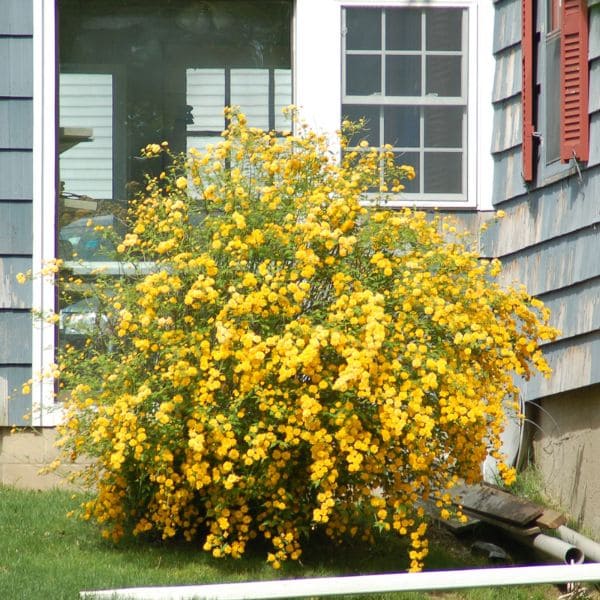
- Plant Size: 1-2 meters in height
- Bloom Time: Spring to early summer
- Sun Exposure: Partial shade to full sun
- Soil Requirement: Well-drained soil
- Hardiness Zones: 4-9
Japanese rose is a deciduous shrub, adorned with bright yellow blooms, that can grow between 1-2 meters in height.
It is also called “Yamabuki” and appears in Japanese culture and poetry symbolizing simplicity and elegance.
This plant features charming, double-petaled yellow flowers that bloom from spring to early summer, and sometimes even make a second appearance in the fall.
One of the standout features of the Japanese rose is its ability to bloom in the shade, a rarity among flowering shrubs.
Besides being a pollinator magnet, the Japanese rose can serve as a low hedge or border plant, thanks to its dense growth habit.
Aaron’s Beard (Hypericum Calycinum)
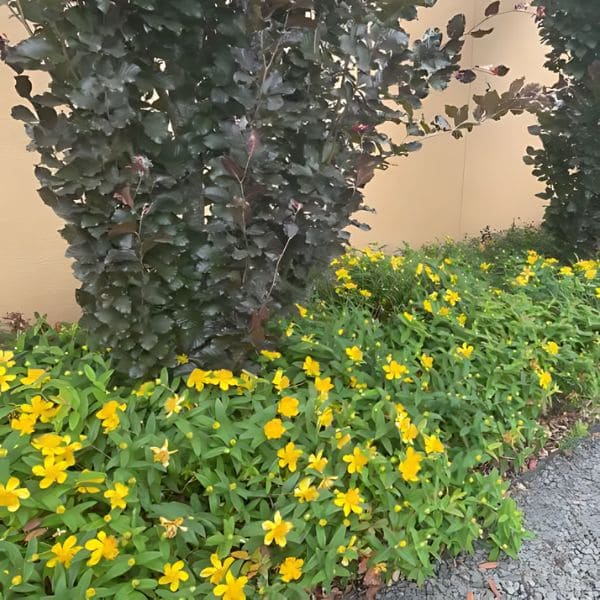
- Plant Size: 0.5-1 meter in height
- Bloom Time: Summer
- Sun Exposure: Full sun to partial shade
- Soil Requirement: Well-drained soil
- Hardiness Zones: 5-9
Aaron’s beard is a hardy evergreen shrub and native to southeastern Europe and western Asia. It boasts large, sunny yellow flowers that bloom throughout the summer.
These flowers with their prominent stamens create a striking display against the dark green, oval-shaped leaves.
One of the remarkable features of Aaron’s beard is its ability to thrive in less-than-ideal conditions, including dry or rocky soils.
Besides, you can pair it with lavender and creeping thyme to attract bees and other pollinators supporting your garden’s ecosystem.
Aaron’s beard is excellent for stabilizing slopes and covering large areas with its dense, mat-forming growth.
It can be used as a ground cover, in rock gardens, or under trees and shrubs helping to prevent soil erosion.
Dyer’s Greenweed (Genista Tinctoria)
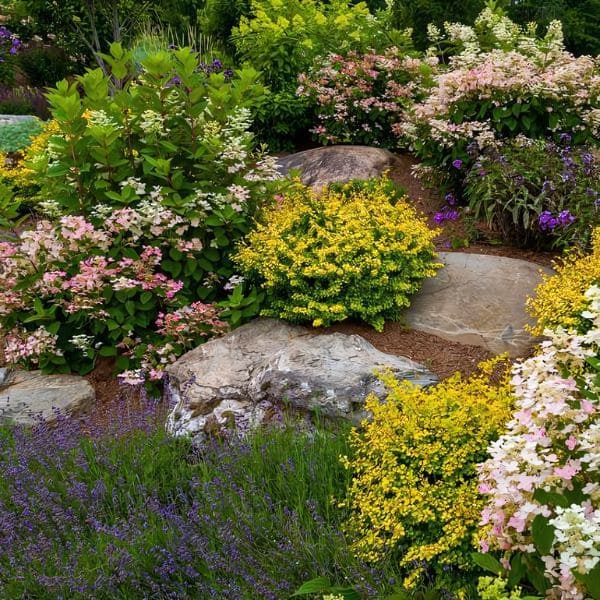
- Plant Size: 1-1.5 meters in height
- Bloom Time: Late spring to summer
- Sun Exposure: Full sun
- Soil Requirement: Well-drained soil
- Hardiness Zones: 3-7
Dyer’s greenweed is a deciduous shrub and native to Europe and Western Asia, suitable for zones 3-7.
It showcases masses of bright yellow flowers from late spring to summer. These blooms stand out against its slender, green stems and small, narrow leaves.
The vibrant yellow flowers are a magnet for bees and other pollinators. It pairs well with other sun-loving plants like lavender and rosemary creating a beautiful and fragrant garden bed.
Besides its beauty, dyer’s greenweed helps improve soil quality by fixing nitrogen benefiting neighboring plants.
One of the unique aspects of dyer’s greenweed is its historical use in dye production. The plant’s name reflects its traditional role in creating yellow dyes for centuries.
Lady Banks’ Rose (Rosa Banksiae Lutea)
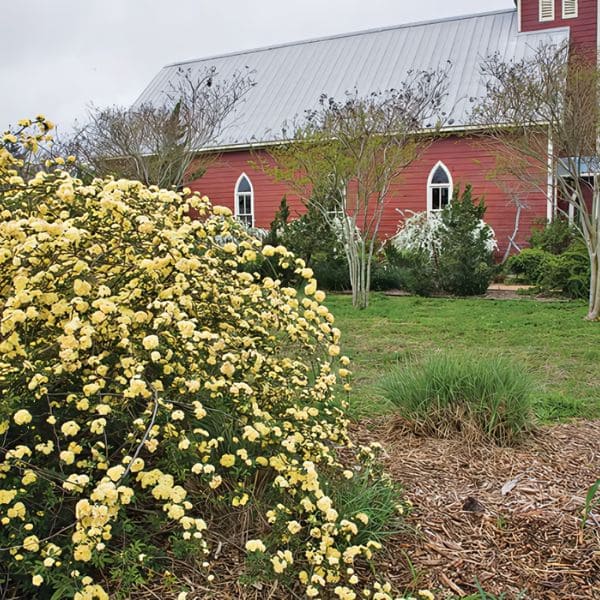
- Plant Size: 2-4 meters in height
- Bloom Time: Spring
- Sun Exposure: Full sun
- Soil Requirement: Well-drained soil
- Hardiness Zones: 6-9
Lady Banks’ Rose is a vigorous, evergreen climbing shrub. It is named after Lady Dorothea Banks, the wife of the famed botanist Sir Joseph Banks.
It was introduced to the West in the early 19th century and has since become a beloved garden favorite.
This plant produces small, double-petaled yellow flowers with sweet scent. Its rose is native to China and features thornless, arching stems and glossy, dark green leaves.
Remember to prune after the bloom period helps maintain its shape and encourages more vigorous growth for the next season.
The flowers of Lady Banks’ rose attract bees and butterflies. Its dense foliage provides excellent cover and habitat for small garden creatures.
Oregon Grape Holly (Mahonia Aquifolium)

- Plant Size: 1-2 meters in height
- Bloom Time: Spring
- Sun Exposure: Partial shade to full sun
- Soil Requirement: Well-drained soil
- Hardiness Zones: 5-9
Oregon grape holly is a hardy evergreen shrub and native to the Pacific Northwest of the United States with a moderate growth rate.
This plant produces clusters of bright yellow flowers in the spring, followed by deep blue berries that resemble grapes.
The evergreen leaves are holly-like, with a glossy, leathery texture and spiny edges. In the fall, they turn a beautiful reddish-purple.
This shrub is excellent for erosion control on slopes and can be used as a hedge or foundation plant.
Its dense foliage provides shelter for small wildlife and contributes to a healthy garden ecosystem.
Specially, its roots and bark have been used for stomach problems, tuberculosis or even dysentery. Also, the Nlaka’pamux people applied yellow dye to their basketry.
Shrubby Cinquefoil (Potentilla Fruticosa)
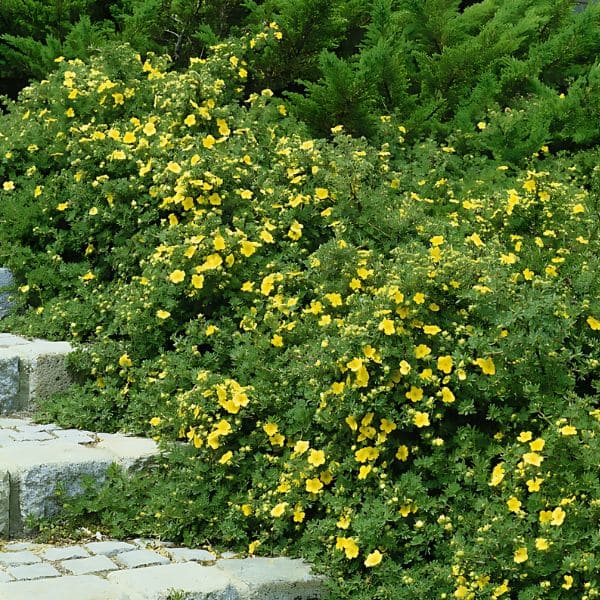
- Plant Size: 0.5-1 meter in height
- Bloom Time: Late spring to fall
- Sun Exposure: Full sun to partial shade
- Soil Requirement: Well-drained soil
- Hardiness Zones: 2-7
Shrubby cinquefoil owns bright yellow flowers from late spring to fall. The five-petaled blooms create a contrast against the fine-textured, green foliage.
One of the standout features of shrubby cinquefoil is its long blooming period, providing color from late spring through fall.
The vibrant flowers attract bees, butterflies, and other pollinators. It pairs well with other sun-loving perennials like lavender and salvia adding layers of color to your garden.
This shrub is excellent for creating low borders, rock gardens, and mass plantings. Its dense growth habit also makes it suitable for erosion control on slopes and banks.
Besides, it is incredibly low-maintenance. It requires minimal pruning, typically done in early spring to remove deadwood and maintain shape.
Rock Rose (Cistus X Luteus)
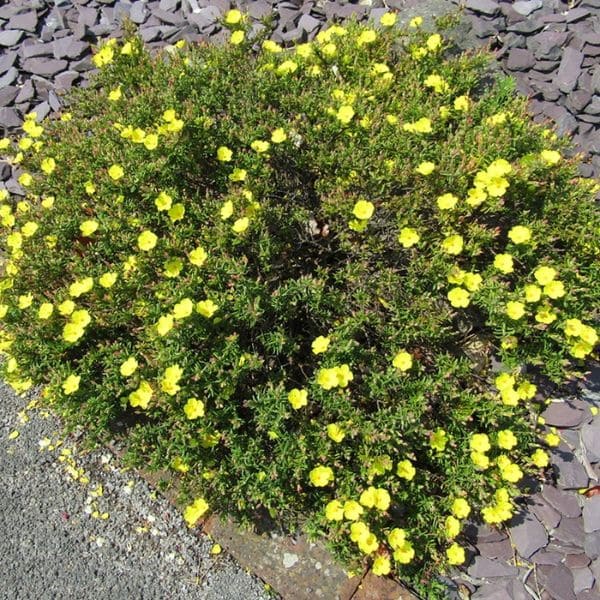
- Plant Size: 1-1.5 meters in height
- Bloom Time: Late spring to summer
- Sun Exposure: Full sun
- Soil Requirement: Well-drained soil
- Hardiness Zones: 8-10
Rock rose is an evergreen shrub and native to the Mediterranean region. It’s hardy in zones 8-10 and is well-suited to dry, rocky conditions.
The rock rose dazzles with bright yellow, papery flowers that bloom from late spring to summer. These blooms are set against dark green, lance-shaped leaves.
They also enhance your garden’s ecological diversity by attracting bees and butterflies and pairing beautifully with other Mediterranean plants like lavender and rosemary.
Additionally, its drought tolerance makes it ideal for water-wise gardens. So, you can use it in rock gardens, as ground cover, or in borders.
Its dense growth helps prevent soil erosion making it both a practical and ornamental choice. People also use it for panic, stress, anxiety, and many other conditions.
Scotch Broom (Cytisus Scoparius)
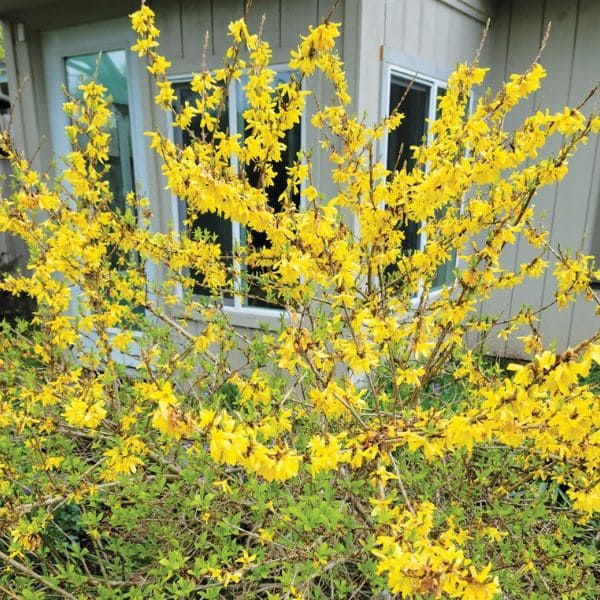
- Plant Size: 1-3 meters in height
- Bloom Time: Late spring to early summer
- Sun Exposure: Full sun
- Soil Requirement: Well-drained, sandy soil
- Hardiness Zones: 5-8
Scotch broom is a deciduous shrub that has an upright, arching growth habit. It showcases a profusion of bright yellow flowers from late spring to early summer.
The blooms, which cover the slender, green stems, create a stunning contrast against the sparse, small leaves.
One of the standout features of Scotch broom is its nitrogen-fixing ability, which enriches the soil and benefits surrounding plants.
Additionally, it enhances the biodiversity of the garden by pairing well with lavender and ornamental grasses, creating a beautiful, drought-tolerant garden.
This shrub is incredibly low-maintenance. You only need to prune after flowering helps maintain its shape and encourages more blooms for the next season.
Spanish Broom (Spartium Junceum)
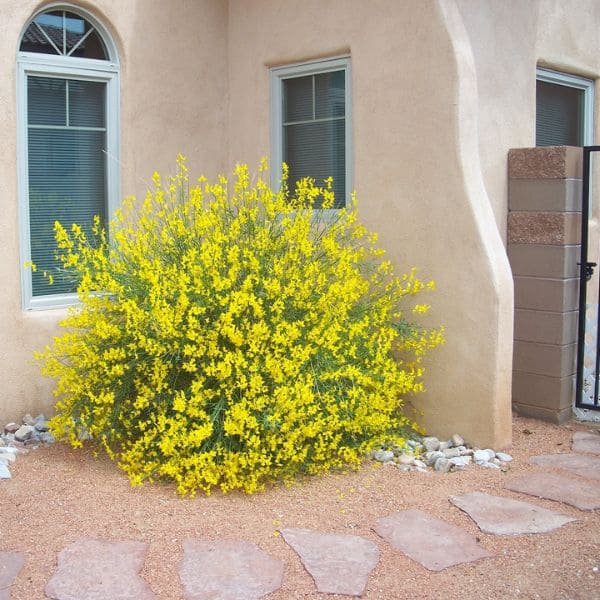
- Plant Size: 1-3 meters in height
- Bloom Time: Late spring to summer
- Sun Exposure: Full sun
- Soil Requirement: Well-drained, sandy or rocky soil
- Hardiness Zones: 6-10
Spanish broom is a deciduous shrub and native to the Mediterranean region.
The name “Spanish broom” reflects its native region and traditional use for making brooms and weaving baskets. Its flowers were also used to produce yellow dye and essential oils.
Spanish broom produces clusters of bright yellow, pea-like flowers from late spring to summer. They are not only visually stunning but also emit a sweet fragrance.
Spanish broom is excellent for stabilizing slopes and can be used in xeriscaping. Its dense root system helps prevent soil erosion making it both a practical choice.
Common Gorse (Ulex Europaeus)
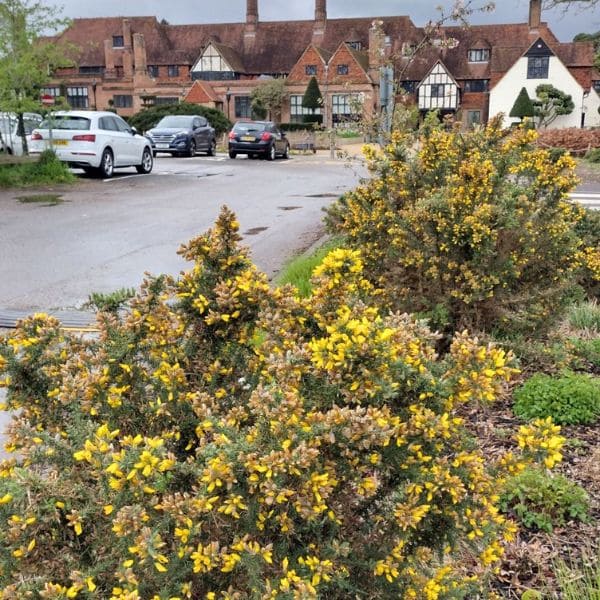
- Plant Size: 1-2 meters in height
- Bloom Time: Primarily spring, with some flowering throughout the year
- Sun Exposure: Full sun
- Soil Requirement: Well-drained, sandy or rocky soil
- Hardiness Zones: 6-9
Common gorse features vivid yellow, pea-like flowers that bloom primarily in spring but can appear sporadically throughout the year.
The dense, thorny branches provide a unique texture and make it an effective barrier plant. Its small, dark green leaves are adapted to conserve water, making it drought-tolerant.
Moreover, the bright flowers attract bees and other pollinators enhancing your garden’s biodiversity.
It pairs well with other sun-loving, drought-tolerant plants like lavender, rosemary, and heather, creating a vibrant and resilient garden space.
This hardy evergreen shrub is incredibly low-maintenance. Pruning after flowering helps maintain its shape and prevent it from becoming too woody.
St. John’s Wort (Hypericum Perforatum)
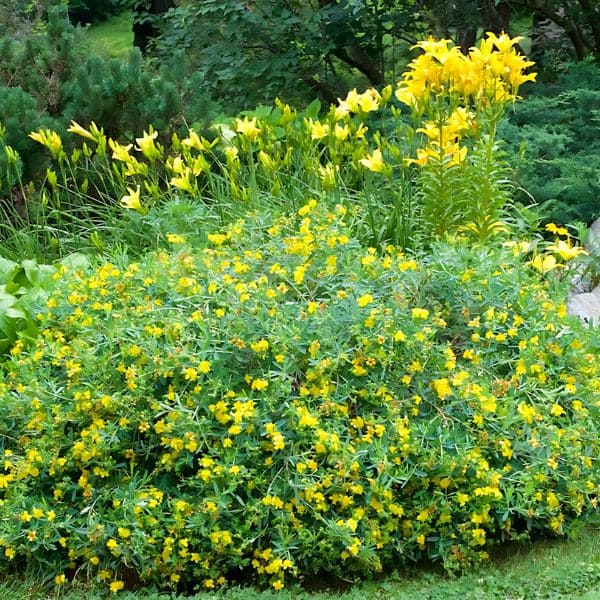
- Plant Size: 0.5-1 meter in height
- Bloom Time: Summer
- Sun Exposure: Full sun to partial shade
- Soil Requirement: Well-drained soil
- Hardiness Zones: 5-9
The name “St. John’s Wort” is derived from St. John the Baptist, as the plant typically blooms around his feast day in late June.
This plant features vibrant yellow, star-shaped flowers The small, oval leaves have tiny translucent dots, giving them a perforated appearance when held up to the light.
St. John’s wort is famous for its potential mood-enhancing properties. Additionally, it can spread and create dense ground cover, slopes and embankments preventing soil erosion.
The bright flowers attract bees and butterflies. It can also pair well with echinacea, and yarrow creating a vibrant ground cover and wildflower gardens.
Japanese Barberry (Berberis Thunbergii)
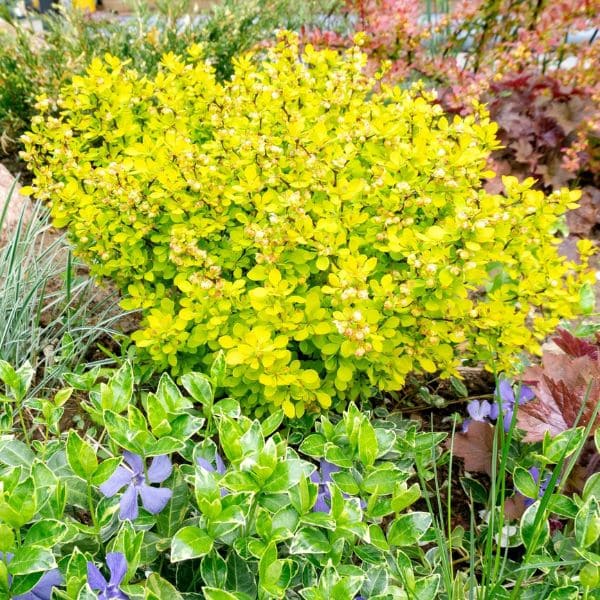
- Plant Size: 1-1.5 meters in height
- Bloom Time: Spring
- Sun Exposure: Full sun to partial shade
- Soil Requirement: Well-drained soil
- Hardiness Zones: 4-8
Japanese barberry gets its name from the Arabic word for the fruit, while “thunbergii” honors the Swedish botanist Carl Peter Thunberg, who introduced the plant to Europe.
Japanese barberry features small, bright yellow flowers that bloom in spring, providing a lovely contrast to its green, red, or purple leaves.
The shrub has a dense, rounded form and small, oval leaves that turn brilliant shades of red and orange in the fall.
Additionally, the plant produces small, red berries in the fall that persist into winter, adding further visual appeal and attracting birds.
This shrub is excellent for borders, hedges, and foundation plantings. Its dense growth habit makes it a good choice for creating privacy screens or defining garden spaces.
Its berries are edible, they contain the compound berberine, which is used in herbal medicine to treat digestive issues and infections.
Curry Plant (Helichrysum Italicum)
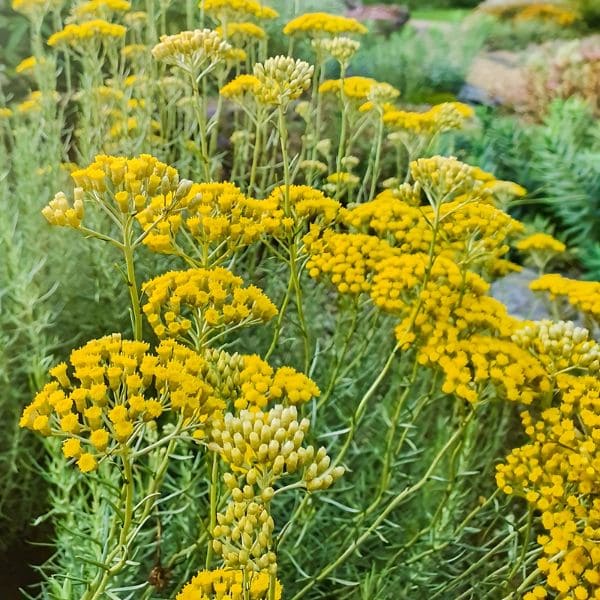
- Plant Size: 0.5-1 meter in height
- Bloom Time: Summer
- Sun Exposure: Full sun
- Soil Requirement: Well-drained, sandy or rocky soil
- Hardiness Zones: 7-10
Curry plant is an evergreen and easy-to-grow shrub. Native to the Mediterranean region, it is hardy in zones 7-10 and is well-suited to hot, dry conditions.
The curry plant boasts clusters of small, bright yellow flowers that bloom in the summer. Its narrow, silver-grey leaves emit a strong, curry-like fragrance.
The bright flowers attract bees and butterflies. It pairs well with other Mediterranean herbs like lavender and thyme, creating a harmonious and fragrant garden space.
Due to drought tolerance and preference for poor soil conditions, this plant is excellent for xeriscaping, rock gardens, and borders.
In traditional Mediterranean medicine, the essential oil of Helichrysum italicum is known for its antibacterial, antifungal, antiviral, and anti-inflammatory properties.
Azalea (Rhododendron spp.)
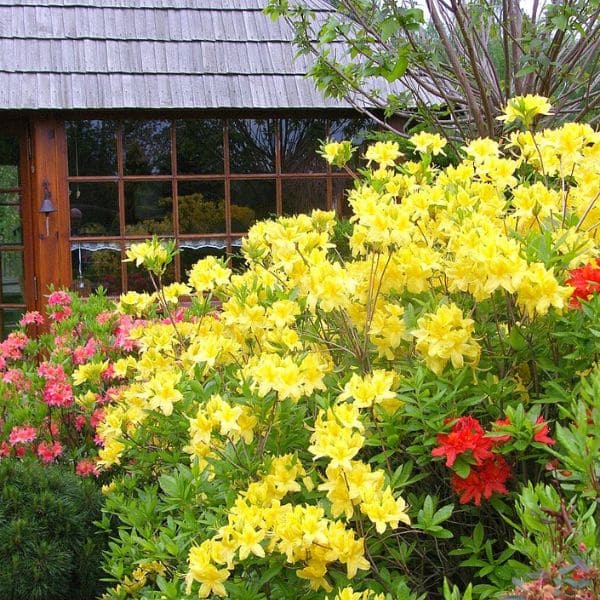
- Plant Size: 1-2 meters in height
- Bloom Time: Spring
- Sun Exposure: Partial shade to full sun
- Soil Requirement: Acidic, well-drained soil
- Hardiness Zones: 4-9
Azalea is a delightful shrub and native to Asia, Europe, and North America. It grows at a moderate rate and thrives in partial shade to full sun.
Azaleas produce a profusion of bright yellow flowers in the spring, creating a breathtaking display. These deciduous or evergreen shrubs have glossy, dark green leaves.
The vibrant blooms of Azaleas attract a variety of pollinators including bees, butterflies, and hummingbirds.
Azaleas are excellent for borders, foundation plantings, and woodland gardens. They pair with ferns, hostas, and hydrangeas creating a lush and layered garden bed.
Their dense growth habit helps control soil erosion and provides shelter for small wildlife.


